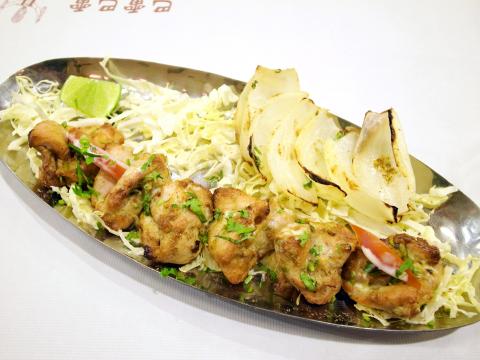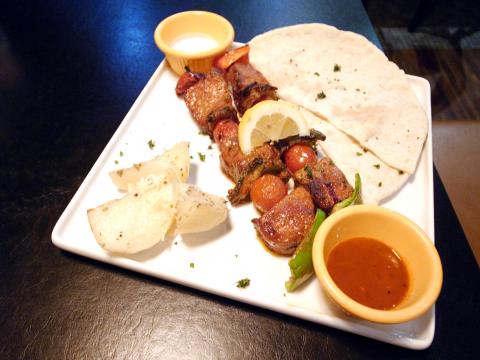Balle Balle Indian Restaurant & Bar
(巴雷巴雷印度餐廳)
Address: 12, Guangfu N Rd, Taipei City (台北市光復北路12號)

Photo: Ho Yi, Taipei Times
Telephone: (02) 2570-7265
Open: Daily from 11:30am to 2:30pm and 5:30pm to 10pm; closed on Mondays
Average meal: NT$600 to NT$800

Photo: Ho Yi, Taipei Times
Details: Menu in Punjabi, English and Chinese; credit cards accepted
Finding a really good Indian restaurant can be a difficult task in Taipei, where choices are limited not so much because of the small number of dining spots, but because of the similar, if not exactly identical, food on offer. Fortunately, progress is occasionally made with the arrival of establishments such as the Balle Balle Indian Restaurant & Bar.
The kitchen is fully devoted to cuisine from the Punjab region of northern India. Compared to the often extensive menus that have the weight of a book at similar establishments, the eatery has a diner-friendly selection of appetizers, tandoori, curry dishes and breads. Ingredients used by the restaurant’s team of Indian chefs come directly from the Indian specialty store which is the owner’s other business venture.

Photo: Ho Yi, Taipei Times
The rich flavors from the Indian subcontinent are finely rendered at Balle Balle. Take the murg malai kebab (NT$380) for example — it is composed of boneless chicken marinated with cashew paste and homemade cream and spices. The tandoori starter delights with the surprisingly tender, succulent meat, accompanied by the slightly charred, lusciously sweet onions.
From the curry section, which includes chicken, lamb, fish and vegetables, veg kofta (NT$290) features soft balls made from mashed potatoes and mixed vegetables submerged in onion and cashew gravy. Spices like ginger and coriander add punch to the delightfully creamy dish.
The gosht rahra (NT$360) delivered a wow effect with the offering of tender, boneless mutton tossed in onion gravy, making for another mild, smooth curry delicacy.
Equally reassuring is the Indian manager known as GV. Speaking fluent English and Mandarin, the manager is as friendly as he is helpful in making recommendations and answering patrons’ needs.
Merlot Cafe & Bistro
(巴夢樂小廚)
Address: 32, Ln 76, Xinsheng N Road Sec 2, Taipei City (台北市新生北路二段76巷32號)
Telephone: (02) 2568-1283
Open: Tuesday to Sunday from 5:30pm to 10pm
Average meal: NT$800 to NT$1,000, 10 percent service charge
Details: English and Chinese menu; credit cards accepted
Experiencing a city on a weekend or over a lifetime inevitably spells great differences. For long-time residents of Taipei, life doesn’t only involve going to Taipei 101 or dining at Din Tai Fung (鼎泰豐). At first glance, Merlot Cafe & Bistro is one of such places that can simply fall off the radar — or never appear in the first place. Ranked No. 1 on TripAdvisor among 8,865 restaurants in Taipei, the intimate bistro is a well-guarded secret among foreign visitors to the city, with relatively little coverage from local food bloggers and journalists. But a closer look reveals something that we all look for in a place to eat, drink and be merry — quality food and a friendly host who knows his customers by their first names.
Small, homey and hidden away in a back alley off the bustling Linsen North Road (林森北路), the establishment appears modest. The interior is neat, clean and has a seating capacity for 20 diners. Often, the smell of food being prepared wafts up from the open kitchen, while Bob Chau (), the gracious Taiwanese-American host from California, glides between tightly packed tables, chatting with patrons about everything from food to life.
Much like the cordial service, Chau’s cooking is also a hearty fare. The lauded chargrilled steak (8oz, NT$490) with sauteed seasonal vegetables is cooked medium-rare to medium and sliced thin. The seasoned beef is as tender and juicy as a good piece of meat should be.
Featuring handmade pastas, Merlot’s kitchen offers a satisfying selection of the Italian staple. Meanwhile, Chau’s rendition of risotto is comfortingly soft, smooth and cooked to a creamy consistency.
YiamasGreeka Taverna
(亞馬仕希臘餐廳)
Address: 3, Ln 181 Anhe Rd Sec 2, Taipei City (台北市安和路二段181巷3號)
Telephone: (02) 2737-0037
Open: Monday to Friday from 11:30am to 3pm and 5:30pm to 11pm, Saturday and Sunday from 11:30am to 11pm
Average meal: NT$500 to NT$800
Details: Menu in Chinese and English, credit cards accepted
On the premises where Toast Bar and Bistro used to stand, Yiamas Greeka Taverna brings a taste of Greece to a neighborhood dominated by Western-style restaurants such as Carnegie’s and Whalen’s. Ambience-wise, the dimly lit restaurant has an intimate, relaxing comfort of a bar, accentuated by a slick palette of wooden brown, dark gray and white. Fluent in Mandarin and English, the wait staff appear both relaxed and attentive. With little knowledge of Greek cuisine, my dining companion and I relied on our server to make recommendations, which turned out to be just as delicious as promised.
One of the highlights is the souvlaki. Served with homemade pita bread, yogurt garlic dressing and roasted potatoes, Yiamas’ rendition of souvlaki features chicken (NT$290), lamb (NT$350) and beef tenderloin (NT$350). The beef we tried was flavorful and went well with the caramelized bell peppers and onions, though the meat seemed to be cooked to the level of medium-well rather than medium that we ordered. The yogurt garlic dressing was good, but in my opinion, the well-flavored, grilled delight needs no other seasoning than the slices of lemon served on the side.
Another highly recommended dish is the kotoupolo lemonato (NT$380), or Greek roasted chicken. Seasoned with lemon, oregano and garlic, the bird was roasted to a succulent, tender perfection, while the fruity, sour fragrance of the lemon wonderfully complemented the otherwise rich plate. The large serving — half a chicken — is best shared among a group.
Good food and drinks aside, Yiamas also hosts comedy nights on a regular basis.

That US assistance was a model for Taiwan’s spectacular development success was early recognized by policymakers and analysts. In a report to the US Congress for the fiscal year 1962, former President John F. Kennedy noted Taiwan’s “rapid economic growth,” was “producing a substantial net gain in living.” Kennedy had a stake in Taiwan’s achievements and the US’ official development assistance (ODA) in general: In September 1961, his entreaty to make the 1960s a “decade of development,” and an accompanying proposal for dedicated legislation to this end, had been formalized by congressional passage of the Foreign Assistance Act. Two

Despite the intense sunshine, we were hardly breaking a sweat as we cruised along the flat, dedicated bike lane, well protected from the heat by a canopy of trees. The electric assist on the bikes likely made a difference, too. Far removed from the bustle and noise of the Taichung traffic, we admired the serene rural scenery, making our way over rivers, alongside rice paddies and through pear orchards. Our route for the day covered two bike paths that connect in Fengyuan District (豐原) and are best done together. The Hou-Feng Bike Path (后豐鐵馬道) runs southward from Houli District (后里) while the

March 31 to April 6 On May 13, 1950, National Taiwan University Hospital otolaryngologist Su You-peng (蘇友鵬) was summoned to the director’s office. He thought someone had complained about him practicing the violin at night, but when he entered the room, he knew something was terribly wrong. He saw several burly men who appeared to be government secret agents, and three other resident doctors: internist Hsu Chiang (許強), dermatologist Hu Pao-chen (胡寶珍) and ophthalmologist Hu Hsin-lin (胡鑫麟). They were handcuffed, herded onto two jeeps and taken to the Secrecy Bureau (保密局) for questioning. Su was still in his doctor’s robes at

Mirror mirror on the wall, what’s the fairest Disney live-action remake of them all? Wait, mirror. Hold on a second. Maybe choosing from the likes of Alice in Wonderland (2010), Mulan (2020) and The Lion King (2019) isn’t such a good idea. Mirror, on second thought, what’s on Netflix? Even the most devoted fans would have to acknowledge that these have not been the most illustrious illustrations of Disney magic. At their best (Pete’s Dragon? Cinderella?) they breathe life into old classics that could use a little updating. At their worst, well, blue Will Smith. Given the rapacious rate of remakes in modern